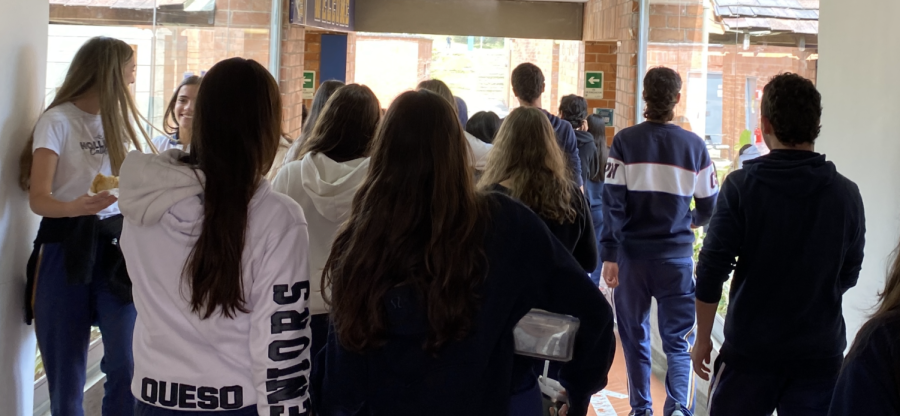Overloaded Classes, Overworked Teachers
The chaos breaks out every time the music begins. The struggle to move. The push and shove. The need to make your way through the stream of bodies moving in the opposite direction. The hopelessness of arriving on time to the classroom at the other end of the building. This is the frustration most of the 476 TCS HS students feel every day.
The number of students in HS has increased every year since 2021. It all began when the sixth classroom, Classroom F, was built in K-4. Since then, every year an additional classroom was built in each grade of the early years, which allowed 24 more students per grade level to join the TCS community each year.
It did not seem to be a problem for MS and HS due to their plentiful classrooms. Yet, the headache began when the Class of ’26 moved on to high school. Suddenly the building had to accommodate 50 students more than it ever had. Many students are concerned that in August 2023, 24 more students will be joining high school.
“I feel like high school currently has an exaggeration of students,” Santiago Lopez, Grade 10, said.
Like every other high school, TCS’s building is designed to take in four grades: 9, 10, 11, and 12. According to The Global Economy.com the average student-teacher ratio in Colombia is 23.3:1. At TCS, the student-to-teacher ratio is 24:1. However, some teachers have classes with up to 27 students.
Unfortunately, TCS is not the only High School facing the overcrowded classrooms issue. Other international institutions claim that the increased number of students per-class oftentimes has a negative repercussion on students learning. Some of these international schools in Mali have a ratio of 37.8:1, whereas the ratio for schools in Costa Rica is 12.2:1.
Some students have voiced concerns that without additional teachers, students will not receive the attention they need to excel in their studies.
“Not only do we get less one-on-one time with teachers during class, but they also have less time for students and are not as available during X-block or office hours,” Jerónimo Mejía, Grade 11, said.
Teachers have also noticed a change in their lectures with the increasing amount of students per class.
“It is more frustrating at times because obviously smaller class sizes can make our lives a little bit easier, make our workload a little lighter and give us time to work with individual students,” David Schas, General and AP Chemistry Teacher, said.
Seniors and 11th graders appear to hold the strongest opinions on the issue of class size. From the beginning of their time at TCS, they only had up to classroom E, meaning they had 24 students less than the class of ’25 and ‘26.
Although some students take pride in the fact that more people are joining TCS, others have mixed feelings or even abhor the idea of a crowded hallway and long lines in the cafeteria.
“It’s great that so many people are interested in our school now, and I wouldn’t want to discourage that,” Senior Maria Jaramillo said.
Yet, like every other student, Jaramillo has to negotiate longer lines, run for every free chair she finds in the cafeteria, and make her way through the moving bodies to arrive at her next classroom.
“You just feel so overwhelmed by the amount of people you see in the hallways, there is no space to do anything,” Jaramillo said.
Along with Juan Fernando Mesa, the TCS Manager of Infrastructure, and School Architect Paula Duque, administrators have worked for 12 years on “Project F.” Even if students and teachers don’t know about it, including a sixth classroom, classroom F, is not a decision taken from one year to another. They have spent 12 years analyzing the implications of adding one more classroom with the maximum capacity of students, a decision made knowing that it would impact the overall financing of the school.
Each year, Duque and Mesa, alongside other TCS administrators, analyze the impact Project F has had in each school and come up with solutions to potential problems. For instance, in 2019, HS directives considered building four new classrooms, then just two, but after evaluating the implications, decided no new classrooms were needed.
“What we have to do is move and adapt things according to the increasing amount of students and their needs,” Duque said.
Decisions such as building or investing in hiring are made not only by thinking about HS but rather the impact of these on the whole school.
“Truly, what we have to do is be more efficient in the management of the classrooms. Building one more classroom of 100m2 costs more than 600 million pesos, and every time we choose to build; green areas will be affected,” Mesa said.
Instead, they used some money to hire a counselor for every grade.
“We call it the pandemic effect. Before COVID-19, we were considering hiring a third counselor for HS, now, we have one per year,” Mesa said. “That is how we make decisions here. Everything can change in a second. We must keep an open mind.”
“The changes made: the new location of the Technology classrooms, the office, the new teacher’s lounge, it all happened for a reason. We are going to have a change inside the classrooms,” Mesa said.
Work Cited
Rickels, K. (n.d.). Overflowing classes and overworked teachers. The Live Wire. Retrieved February 20, 2023, from https://thelibertylivewire.com/8184/clubs-academics/overflowing-classes-and-overworked-teachers/
Student teacher ratio, primary school by country, around the world. TheGlobalEconomy.com. (n.d.). Retrieved February 20, 2023, from https://www.theglobaleconomy.com/rankings/student_teacher_ratio_primary_school/#:~:text=The%20average%20for%202018%20based,countries%20where%20data%20are%20available.
Wilsey, M. (n.d.). Chaos in the classroom. The Echo. Retrieved February 20, 2023, from https://slpecho.com/news/2022/10/17/chaos-in-the-classroom/




